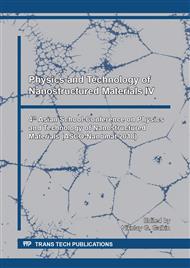p.172
p.181
p.186
p.191
p.196
p.201
p.207
p.214
p.219
Non-Invasive Temperature-Feedback SERS with all-Dielectric Resonant Nanostructures
Abstract:
All-dielectric resonant micro-and nanostructures emerge as a promising platform, which can complement the metal-based counterparts in routine biosensing measurements based on surface-enhanced Raman scattering (SERS). However, lack of in-situ temperature control limits performance of nanostructures for precise SERS-based applications. Here, we present an approach for SERS measurement with simultaneous temperature control and employ Raman spectroscopy to mapping of temperature-dependent Raman signal distribution. We attest a chemically inert black silicon (b-Si) substrate for a non-invasive (chemically non-perturbing) SERS identification of the molecular fingerprints at low concentrations. Additional studies of the slow daylight-driven para-aminothiophenol (PATP)-to-4,4'-dimercaptoazobenzene (DMAB) catalytic conversion in the aqueous methanol solution loaded with colloidal silver nanoparticles confirm the non-invasive SERS performance of the all-dielectric crystalline b-Si substrate. Proposed SERS substrates can be fabricated using easy-to-implement scalable technology of plasma etching making such inexpensive all-dielectric substrates promising for routine SERS applications, where the temperature-feedback and the noninvasiveness are of mandatory importance.
Info:
Periodical:
Pages:
196-200
Citation:
Online since:
September 2018
Authors:
Price:
Сopyright:
© 2018 Trans Tech Publications Ltd. All Rights Reserved
Share:
Citation:


